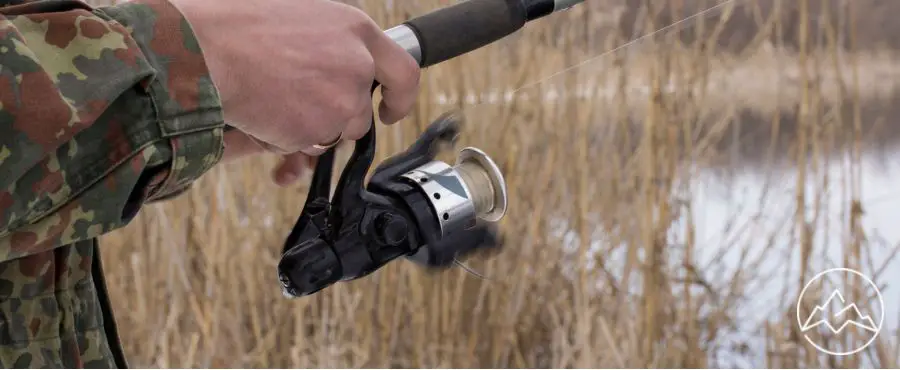Many beginner fishing enthusiasts have difficulty nailing down the right technique for spooling their spinning reel. Follow our guide for a tried-and-true method for how to spool a spinning reel that you can turn to each time until you have the procedure memorized.
Picking the best line
Before we get into the actual spooling technique, you should take care to select the optimal line that will bring you the most success. Not every line is ideal for every fishing scenario.
Types
There are three major types of fishing lines. Let’s go over them one by one.
Braided
Braided lines are made from several lengths of synthetic material. As you might guess from their name, they are braided together to create a single cohesive line that barely stretches. This gives braided lines unparalleled durability when compared to their competitors.
Braided lines tend to sink very slowly, so they’re great for fishing with topwater baits. However, braided lines also weigh a little bit more than the other two types, so it can be hard to cast them to further distances.
Choose braided lines when bottom fishing.
Monofilament
Monofilament lines are usually made from nylon. These are also single-strand lines and are generally some of the cheapest you can find, largely due to their ubiquity in fishing supply shops’ overall commonality.
Monofilament lines tend to stretch fairly well. Setting hooks can be a little tricky without the right experience, but a few tries are enough to let most people use them effectively. Monofilament lines can be particularly advantageous if you use treble-hook-laden lures.
Their stretching and flexibility are a benefit since it prevents the lure and hooks from accidentally slipping out of a fish’s mouth
Use monofilament fishing lines for use with floating baits or live baits.
Fluorocarbon
Finally, fluorocarbon lines are relatively new when compared to the other two options. Despite their rarity, they are rapidly increasing in popularity. They are made from a single strand just like typical monofilament lines. But they are not made from nylon and are instead made from a tougher material that is also extremely thin.
This makes fluorocarbon lines hard for many different types of fish to spot underwater. They can be particularly effective for fish that resist more easily-visible lines. They are moderately stretchy and can resist abrasion to some extent.
Use fluorocarbon lines for fishing in shallow or otherwise calm waters. They’re also great for use in water that is very clear.
Going on a fishing trip soon? You may also want to check out our top picks for the best baitcasting reels.
How to put a line on a spinning reel
Now that you’ve chosen your optimal line for your needs let’s go over the actual technique for spooling a spinning reel
Before you begin
Check your chosen reel and see if it turns counterclockwise or clockwise. To determine this, just hold the reel as if you were actually fishing and turn it a few times to see how it rotates. You will use this information when loading the line into the reel.
In addition, you should open your bail on your reel by flipping the small handle up. Load the line through the rod guides and secure it before loading.
Step one
First off, you should let your spool flat on the floor. Make sure that the line of the spool is oriented in the direction that it will be entering the reel. This will avoid tangling or twisting. Don’t be afraid to flip the line if necessary.
Step two
Pinch the line above the reel and pull it as tight as you dare. You should then crank the wheel around 20 times and slowly let the line proceed through your pinched fingers. Every so often, it’s a good idea to check the line for twists and give it a little slack if everything is going well.
Step three
Crank the wheel further and continue to load the line in as you inspect and ensure that it doesn’t twist. Every 20 to 30 cranks are a great increment to check for further imperfections.
Step four
You should continue filling the spool until the line reaches about 1/8 of an inch away from the rim. This gives you plenty of line without overfilling the reel and potentially causing trouble.
Step five
Use your line cutters to cut the line close to the supply spool. You need some excess line to secure the free end with your chosen lure. You can use a little bit of tape over the free end of the spool to stop your extra line from unraveling over time.
Step six
Finally, secure the free end of your line using a clip, lure, or swivel. If you have none of those, a rubber band works just as well. This will keep the line secure during transit and prevent it from slipping.
FAQs About How to Spool a Spinning Reel
What is the proper way to spool a spinning reel with new fishing line?
How do you determine the correct amount of fishing line to spool on a spinning reel?
What types of fishing line are best suited for spinning reels, and why?
How can you prevent line twists and tangles when spooling a spinning reel?
Should you use backing when spooling a spinning reel, and if so, how much and what type of backing is best?
Conclusion: How to spool a spinning reel
Following the above guidelines will ensure that you have a well-spun reel every time you head out to fish. Thanks for reading!



